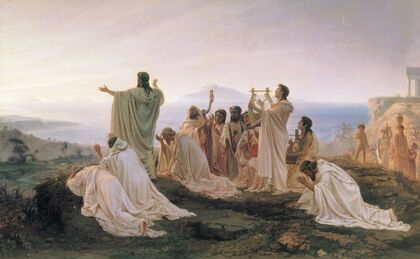Crotona: Difference between revisions
(Added image, fixed typo) |
PeterDuffy (talk | contribs) (Marked this version for translation) |
||
| (One intermediate revision by the same user not shown) | |||
| Line 1: | Line 1: | ||
[[File:Bronnikov gimnpifagoreizev.jpg|thumb|Pythagoreans celebrate sunrise, Fyodor Bronnikov (1869)]] | <languages /> | ||
[[File:Bronnikov gimnpifagoreizev.jpg|thumb|upright=1.4|<translate><!--T:1--> Pythagoreans celebrate sunrise, Fyodor Bronnikov (1869)</translate>]] | |||
<translate> | |||
<!--T:2--> | |||
'''Crotona''' is a Greek seaport in southern Italy where, in the sixth century <small>B</small>.<small>C</small>. [[Pythagoras]], the Greek philosopher and mathematician (an embodiment of [[Kuthumi]]), founded a brotherhood of initiates. The devotees who were accepted into this [[mystery school]] pursued a philosophy based on the mathematical expression of universal law, illustrated in [[music]] and in the rhythm and harmony of a highly disciplined way of life. | |||
<!--T:3--> | |||
Members of this scientific-religious brotherhood progressed through a series of initiations. They delved into the mysteries of preexistence and the afterlife, and of creation. The students were taught that by mastering their feelings and purifying their souls, they could become, as Pythagoras’ “Golden Verses” states, “a deathless God, Divine, mortal no more.” | Members of this scientific-religious brotherhood progressed through a series of initiations. They delved into the mysteries of preexistence and the afterlife, and of creation. The students were taught that by mastering their feelings and purifying their souls, they could become, as Pythagoras’ “Golden Verses” states, “a deathless God, Divine, mortal no more.” | ||
About 500 <small>B</small>.<small>C</small>. a rejected candidate of Pythagoras’ Academy incited a violent persecution resulting in the Master’s death, the dissolution of his community, and the tragic destruction of much of his teaching. | About 500 <small>B</small>.<small>C</small>. a rejected candidate of Pythagoras’ Academy incited a violent persecution resulting in the Master’s death, the dissolution of his community, and the tragic destruction of much of his teaching. | ||
== See also == | == See also == <!--T:4--> | ||
<!--T:5--> | |||
[[Pythagoras]] | [[Pythagoras]] | ||
<!--T:6--> | |||
[[Kuthumi]] | [[Kuthumi]] | ||
== Sources == | == Sources == <!--T:7--> | ||
<!--T:8--> | |||
{{CCL}}. | {{CCL}}. | ||
<!--T:9--> | |||
''Heart'' magazine, Winter 1985. | ''Heart'' magazine, Winter 1985. | ||
</translate> | |||
Latest revision as of 15:07, 19 August 2022

Crotona is a Greek seaport in southern Italy where, in the sixth century B.C. Pythagoras, the Greek philosopher and mathematician (an embodiment of Kuthumi), founded a brotherhood of initiates. The devotees who were accepted into this mystery school pursued a philosophy based on the mathematical expression of universal law, illustrated in music and in the rhythm and harmony of a highly disciplined way of life.
Members of this scientific-religious brotherhood progressed through a series of initiations. They delved into the mysteries of preexistence and the afterlife, and of creation. The students were taught that by mastering their feelings and purifying their souls, they could become, as Pythagoras’ “Golden Verses” states, “a deathless God, Divine, mortal no more.”
About 500 B.C. a rejected candidate of Pythagoras’ Academy incited a violent persecution resulting in the Master’s death, the dissolution of his community, and the tragic destruction of much of his teaching.
See also
Sources
Jesus and Kuthumi, Corona Class Lessons: For Those Who Would Teach Men the Way.
Heart magazine, Winter 1985.
